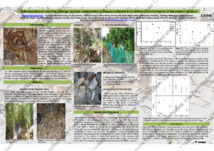Bothrops atrox in captivity, change isotopic composition in tissues collected from different environments of the eastern Amazon.
Bothrops atrox in captivity, change isotopic composition in tissues collected from different environments of the eastern Amazon.
Author(s): MARTINEZ, M. G.; CHALKIDIS, H. de M.; MOURA, A. M.; OLIVEIRA JUNIOR, R. C. de; CAMARGO, P. B.
Summary: The Bothrops Atrox is little studied because it is sympatric to Amazonian animals. Very little is known about the ecology and natural history of this species. It has a generalist diet and the distribution of this species is very wide. The adults forage mostly on the ground, while the younger animals prefer to stay on the vegetation. They are easily found in the rainy months in areas near lakes or that are seasonally flooded and they are difficult to find in the driest months, a period when there is less availability of prey in these environments. Due to its aggressiveness it is considered one of the most feared snakes in South America and in the eastern Amazon, being responsible for the largest number of snakebites in the region. Through measuring stable isotope carbon-13 and nitrogen-15, it is intended to characterize the variations of the feeding habits of these collected animals in different environments and also when they are kept in captivity, (feeding the animal's bioterium).
Publication year: 2014
Types of publication: Abstract in annals or event proceedings
Unit: Embrapa Eastern Amazon
Keywords: Amazonia, Animal, Cobra, Composição isotópica, Tecido
Observation
Some of Embrapa's publications are published as ePub files. To read them, use or download one of the following free software options to your computer or mobile device. Android: Google Play Books; IOS: iBooks; Windows and Linux: Calibre.
Access other publications
Access the Agricultural Research Database (BDPA) to consult Embrapa's full library collection and records.
Visit Embrapa Bookstore to purchase books and other publications sold by Embrapa.

